
Tashkent ) or Toshkent, historically known as Chach, is the capital and largest city of Uzbekistan. It is the most populous city in Central Asia, with a population of 3 million. It is located in northeastern Uzbekistan, near the border with Kazakhstan. Tashkent comes from the Turkic tash and kent, literally translated as "Stone City" or "City of Stones".

Tashkent University of Information Technologies named after Muhammad ibn Musa al-Khwarizmi often abbreviated as ТАТU or TUIT is one of the largest universities in Uzbekistan, located in its capital Tashkent. Tashkent University of Information Technologies was in 1955 founded as Tashkent Electro Technical Institute of Communication and it was the major and only producer of communication engineers for the Central Asian region. Today, it is one of the major universities to nurture ICT talent in Uzbekistan. The university was named after Al-Khwarizmi by a presidential resolution to further boost its role within the nation and abroad.

National University of Uzbekistan (NUUz) (Uzbek: Mirzo Ulugʻbek nomidagi Oʻzbekiston Milliy Universiteti, OʻzMU) is a public university located in Tashkent, Uzbekistan. NUUz is the oldest and largest university in Uzbekistan.

The Milliy Stadium, formerly Bunyodkor Stadium is a football stadium in the city of Tashkent — the capital of Uzbekistan. Located in Chilanzar District of Tashkent, on Bunyodkor Avenue. It seats 34,000 spectators, thus becoming the second largest stadium in Uzbekistan after the Pakhtakor Stadium, which seats 35,000 spectators. It is the home arena of the FC Bunyodkor and Uzbekistan national football teams.

Inha University in Tashkent or IUT is a branch of the Korean Inha University in Tashkent, Uzbekistan. Inha University in Tashkent has two departments - School of Computer and Information Engineering, and the School of Logistics.

Tashkent State Technical University (TSTU) is one of the oldest universities of Uzbekistan. Currently, the university consists of 6 faculties, and prepares highly skilled professionals in technical and engineering fields. For this year, it is estimated to run 56 departments with over 10 746 students, who are taught by 6 academicians of the Academy of Sciences of Uzbekistan, 74 doctors of sciences and 314 candidates of sciences.
The Tashkent Automobile and Road Construction Institute was established in Tashkent, Uzbekistan to meet the high demands for professionals in the transportation and automobile fields.

The Alisher Navoi State Museum of Literature of the Academy of Sciences of Uzbekistan is a scientific-cultural, educational establishment which mainly focuses on collecting and researching the historical materials and objects which are related to Uzbekistan's history. The museum plays a role in the cultural development of young generations in Uzbekistan and it keeps various documents, manuscripts from the Middle Ages.

Tashkent Museum of Railway Equipment is a railway museum in Tashkent and is the only such museum in Uzbekistan.

Museum of Victims of Political Repression in Tashkent — is a museum which tells the history of Uzbekistan during the time of the Soviet Union, in particular that of the people killed by the Soviet government at that time. The Museum is divided into 10 parts.

The Museum of Geology in Tashkent, Uzbekistan is a geology museum that shows and represents the wealth of mineral and geological resources in Uzbekistan, including valuable stones, minerals and archaeological and paleontological findings.
The Uzbekistan State Museum of Nature is the oldest museum operating in Uzbekistan. The museum's main purpose is to show the natural beauty of Uzbekistan and to help protect its environment. The museum features chronologically-ordered exhibits and seeks to educate visitors about Uzbekistan's geography through time.
Art Gallery of Uzbekistan is established in Tashkent city, after the Independence of Republic Uzbekistan, and became one of the most visited modern museums of local people in Uzbekistan.
The Tashkent Polytechnical Museum is an automotive museum in Tashkent, Uzbekistan. The museum provides technical and mechanical information about cars made from 1800 to 1900, focusing on the history of automobile technology and production in Uzbekistan and around the world. It is located in the Mirabad district of Tashkent.
The Museum of Health Care of Uzbekistan is in Uzbekistan. It was established in order to contribute information about the medicine and hygiene among the Uzbek people in an interesting way.
Tashkent Planetarium is one of the newest constructions in Uzbekistan, and is visited by local people and tourists. Tashkent Planetarium provides visitors with the opportunity to look at outer space, even in the morning, and enlarge their knowledge about the cosmos and the whole universe.

Management Development Institute of Singapore in Tashkent (MDIST) is one of the first international university branches to open in Uzbekistan. It was established to meet the high demand for professionals in various fields. Since its founding, it has trained more than 4,500 graduates.

Uzbekistan State University of World Languages is a public university located in Tashkent, Uzbekistan. Islam Karimov established this university by merging two language institutions in 1992.

South Korea-Uzbekistan relations are the international relations between South Korea and Uzbekistan.














